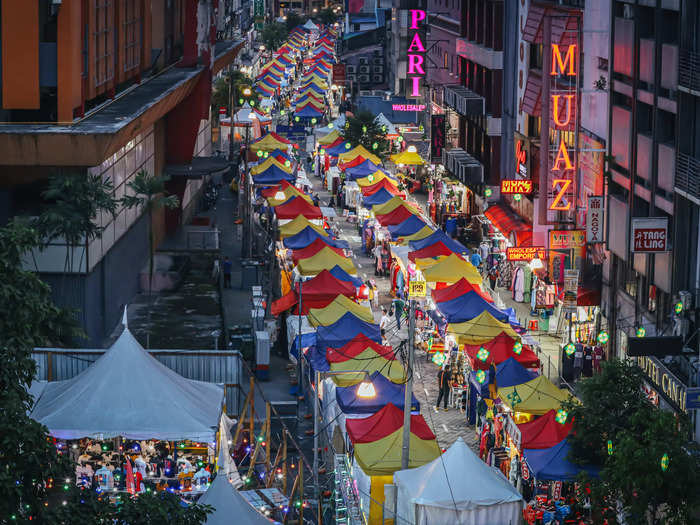
I'm a big fan of mee goreng — and this Malaysian version is one of my favorites.Marielle Descalsota/Insider

Malaysia's capital city Kuala Lumpur is known for its vibrant food scene, with an eclectic mix of ethnic Malay, Chinese, and Indian cuisines. Mee goreng mamak, a stir-fried noodle dish, is considered one of the country's most delicious foods.
It's a dish I eat regularly in Singapore, so I was curious to see if the Malaysian version was any different. During a reporting trip to Kuala Lumpur, I visited a local mamak stall to try their rendition of the noodles.

Mamak stalls are eateries that serve affordable and casual Indian Muslim cuisine in Singapore and Malaysia. Tamil Muslims usually run these stalls.
Restoran Yusoof dan Zakhir is a popular mamak stall in the city center, located a few minutes away from the hostel I was staying at. It has a four-star rating on Google from over 900 reviews.
"So far, the best place to get cheap and delicious food," one Google user wrote. "100% will come back again if I have another chance to go to Malaysia."
One local reviewer rated it as "the best mamak shop" in Kuala Lumpur's Chinatown neighborhood.

When I arrived at the restaurant at 9 p.m. for dinner, there were fewer than 10 people there. A large menu featuring dozens of dishes was plastered on the walls.
I paid 7 Malaysia ringgit ($1.60) for the mee goreng mamak. The dish is typically cheaper in Kuala Lumpur than in Singapore. While it costs between 4 to 6 dollars ($2.90 to $4.30) in Singapore, mamak stalls sell it for 5 to 8 ringgit ($1.15 to $1.80) in Kuala Lumpur.

Mee goreng mamak is typically made with yellow noodles, dried chili, soy sauce, eggs, and a choice of chicken, mutton, or seafood, according to recipe website Rasa Malaysia.
In Singapore, the "merah" version — which means "red" in Malay — is more popular; food coloring gives the noodles a bright red hue. The noodles are usually topped with a fried egg.

The dish looked less intimidating than the bright red noodles served in Singapore.
A few staff members laughed when I told them mee goreng mamak had officially been crowned one of Malaysia's top dishes.
"Mee goreng mamak is famous among tourists," Wathim, a server at the stall, told me. "It's not written on the menu, but they still order."

Another server at the hall, who declined to be named, added that Malaysian food is more than just mee goreng. He said that nasi lemak, a fragrant rice dish, is better.
The restaurant served various curries and gravies from metal trays (pictured above). Locals typically eat bread or rice with these sauces.
Some of the restaurant's most popular dishes include roti canai, a flatbread eaten with curry or a spicy gravy, and nasi goreng, a fried rice dish popular in Southeast Asia.
"Malaysians enjoy eating these dishes for supper," a local named Lau told me. "It's cheap and good."

The noodles had a delicious umami flavor. I devoured the meal in less than 10 minutes.
While the Malaysian version was much milder in spice, I found the flavors more balanced than the ones I've had in Singapore. For less than $2, it was a filling meal and one that I'll order again whenever I'm in Malaysia.
 I spent $2,000 for 7 nights in a 179-square-foot room on one of the world's largest cruise ships. Take a look inside my cabin.
I spent $2,000 for 7 nights in a 179-square-foot room on one of the world's largest cruise ships. Take a look inside my cabin. Saudi Arabia wants China to help fund its struggling $500 billion Neom megaproject. Investors may not be too excited.
Saudi Arabia wants China to help fund its struggling $500 billion Neom megaproject. Investors may not be too excited. Colon cancer rates are rising in young people. If you have two symptoms you should get a colonoscopy, a GI oncologist says.
Colon cancer rates are rising in young people. If you have two symptoms you should get a colonoscopy, a GI oncologist says. Groww receives SEBI approval to launch Nifty non-cyclical consumer index fund
Groww receives SEBI approval to launch Nifty non-cyclical consumer index fund
 Retired director of MNC loses ₹25 crore to cyber fraudsters who posed as cops, CBI officers
Retired director of MNC loses ₹25 crore to cyber fraudsters who posed as cops, CBI officers
 Hyundai plans to scale up production capacity, introduce more EVs in India
Hyundai plans to scale up production capacity, introduce more EVs in India

Copyright © 2024. Times Internet Limited. All rights reserved.For reprint rights. Times Syndication Service.